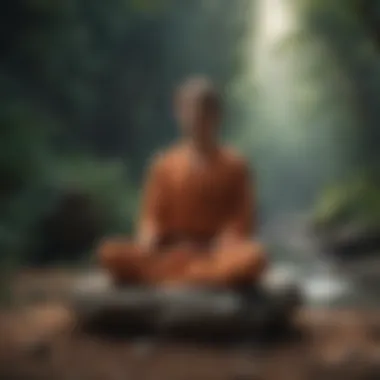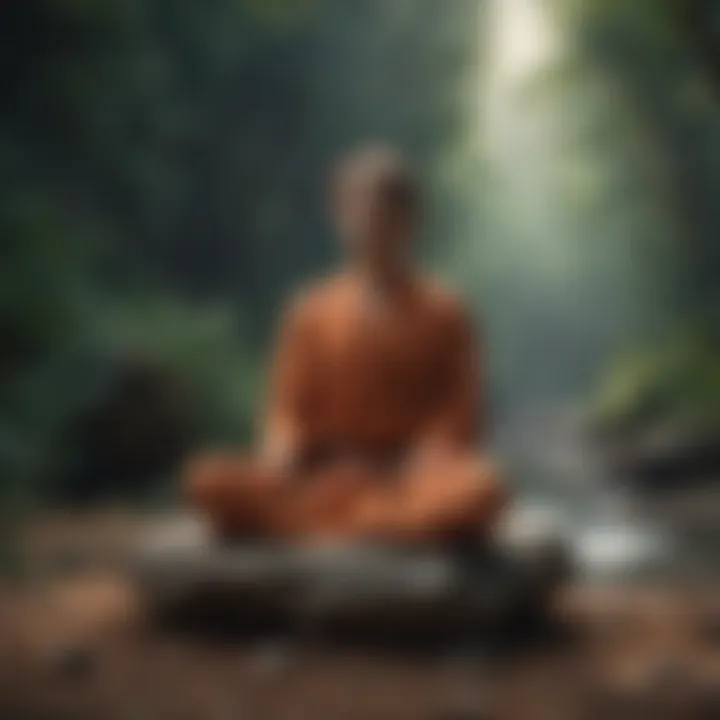Discover Effective Relaxation Techniques for Peace


Intro
In a world that often feels like it's moving at breakneck speed, finding ways to unwind and recharge is becoming more essential than ever. Each day, we juggle countless responsibilities; work, family, and social commitments fill our calendars, leaving little time for ourselves. Amid this whirlwind of obligations, relaxation techniques emerge as lifelines, guiding us toward tranquility.
This guide aims to explore proven methods that help combat stress and promote a sense of well-being. From meditation to engaging in creative activities, each approach is designed to provide solace in the face of life's demands.
Understanding the breadth of these relaxation techniques not only enriches our daily lives but significantly contributes to our mental health. The insights you'll gain here can serve as stepping stones toward a more balanced existence, allowing you to reclaim your peace of mind.
As we journey through this guide, we will uncover the benefits of guided meditation, delve into various techniques and practices, and discuss how these strategies can be woven into the fabric of our everyday lives.
Let’s dive in!
Understanding the Importance of Relaxation
In today’s fast-paced world, finding time to relax may seem like a luxury rather than a necessity. But understanding the core importance of relaxation is essential for maintaining both mental and physical health. Relaxation is not just about kicking back and watching television; its impact reaches deep into our psychological well-being, enhancing our overall quality of life.
The ability to unwind plays an integral role in helping individuals recharge their batteries. Many might not realize that regular relaxation can lead to improved focus and better decision-making. A mind freed from the chains of stress can think clearer, making a significant difference in both personal and professional settings.
Moreover, incorporating relaxation into daily routines can serve as a proactive shield against chronic stress. When one learns to manage stress through effective relaxation techniques, they likely experience not only tangible health benefits but also a shift in perspective regarding life’s challenges.
The Psychological Benefits of Relaxation
The psychological benefits of relaxation are vast and varied. Embracing relaxation can lead to significant decreases in anxiety and depression levels. One of the most immediate effects is the improvement in mood. It’s as if a heavy cloud is lifted, allowing one to view the world more positively. When stress dissipates, clarity comes into play. The mind functions more efficiently, leading to greater creativity and problem-solving abilities.
Relaxation techniques, such as mindfulness and deep-breathing exercises, have shown to cultivate a sense of inner peace. Imagine standing on a mountain, taking a deep breath of fresh air; that’s the essence of the tranquil state achieved through relaxation. As the tension melts away, one also strengthens their emotional resilience, making it easier to adapt to future stressors.
"Taking time to relax is not just a treat — it's a fundamental part of maintaining mental health."
Physiological Changes During Relaxation
While relaxation is mentally rejuvenating, it also orchestrates a cascade of physiological changes that can transform the body. When a person relaxes, the heart rate slows down, and the body's production of stress hormones decreases. This signifies a shift from the 'fight or flight' response that often plagues individuals during stressful periods.
Blood pressure drops, contributing to overall cardiovascular health. Muscles begin to relax, alleviating tension that accumulates from daily stressors. This chain reaction fosters a heightened state of wellbeing, which can be observed in enhanced immune function and improved sleep patterns. In a nutshell, when the body relaxes, it undergoes a unique rejuvenation process that can mitigate the wear and tear of life’s pressures.
The effects of relaxation are not just short-lived. Regular practice can lead to long-term health improvements, which is crucial in a time when lifestyle-related ailments are on the rise. Thus, understanding relaxation’s importance is key to recognizing its potential to elevate one’s overall quality of life.
Meditation as a Tool for Relaxation
Meditation serves as a cornerstone in the quest for relaxation, offering a variety of mental and emotional respite techniques. It’s like a sturdy anchor amidst the tumultuous waves of modern stressors. Engaging in meditation can lead to numerous benefits, such as improved focus, emotional stability, and a stronger sense of peace. Not only does meditation allow one to disconnect from the daily grind, it creates a dedicated space where the mind can simply be—untethered and free.
When exploring this topic, it's crucial to consider that meditation isn't a one-size-fits-all remedy. Different people find solace in different techniques. For someone who thrives on mental clarity, mindfulness may resonate strongly. While on the other hand, the structured approach of Transcendental Meditation might suit those who crave routine. No matter the choice, the importance of meditation as a tool for relaxation should not be underestimated.
Different Types of Meditation Techniques
Mindfulness Meditation
Mindfulness meditation centers on the present moment. One key aspect of this practice is paying close attention to thoughts, sensations, and emotions without judgment. This non-judgmental awareness fosters a deeper connection to one’s own feelings. You know that feeling when you're lost in thought, perhaps fretting about the future or ruminating about the past? Mindfulness nudges you back to the here and now.
The major appeal for many in this practice lies in its accessibility; anyone can pause and take a moment to simply observe their thoughts and surroundings. A universal feature of mindfulness meditation is its proven ability to reduce anxiety and stress by grounding individuals in reality. While mindfulness brings tremendous upside, it does require consistent practice to reap its fully-fledged benefits.
Transcendental Meditation
Transcendental Meditation, or TM as it’s often abbreviated, stands apart due to its structured approach. TM involves silently repeating a mantra, which is believed to carry transformative powers. This practice typically requires guidance from a certified teacher, which might deter some seekers of relaxation, but the discipline can lead to profound results.
For many, TM is appealing because it feels like setting a personal appointment with oneself—a ritual to wind down. This method facilitates a deep state of rest, which calms the nervous system. However, critics might argue that the need for formal instruction and the cost can create barriers. But for those who embrace TM, the rewards can often outweigh the challenges.
Loving-Kindness Meditation
Loving-Kindness Meditation focuses on cultivating an attitude of love and kindness towards oneself and others. Through repeating phrases of goodwill, this practice is designed to enhance one's empathy and compassion. It's something akin to watering a garden—nurturing not just your own spirit, but that of others too.
What makes this form of meditation particularly valuable is its dual impact: while it seeks to expand your ability to give and receive love, it also alleviates feelings of resentment and negativity. Not everyone may feel comfortable initially; it can feel a bit awkward to wish goodwill towards oneself. However, as one continues the practice, the inner ease and warmth begin to blossom.
Guided Sessions for Beginners
For those just dipping their toes into the world of meditation, guided sessions can act as a comforting bridge. Online platforms, apps, or local classes can introduce newbies to this enriching practice in a supportive way. They take the guesswork out by providing structured sessions, ensuring newcomers don’t feel like they are swimming against the current. Guided sessions often include soothing narrations that lead practitioners through specific techniques, helping them focus their thoughts and breathe deeply.
In summary, meditation represents a diverse avenue for relaxation, with its varied techniques accommodating different styles and preferences. Each technique serves distinct needs, providing multiple paths to tranquility. The key takeaway is to experiment and find what resonates most, enabling the mind and body to unwind effectively.
Mindfulness Practices Outside of Formal Meditation
The concept of mindfulness often conjures images of serene meditation sessions, where individuals sit with closed eyes and intentional breaths. However, mindfulness can extend far beyond these formal sessions. It encompasses a range of practices embedded in daily activities that allow us to cultivate awareness and presence in our everyday lives. This approach highlights the accessibility of mindfulness, suggesting that moments of calm can be found even in the busiest of routines.
Benefits of Mindfulness Beyond Meditation:
One of the profound advantages of incorporating mindfulness into daily life is its potential to increase overall well-being. People often find themselves swept up in the whirlwinds of routines and responsibilities, leaving little room for reflection or self-awareness. By bringing mindfulness into tasks we frequently engage in, such as walking, washing dishes, or even waiting in line, we can foster a greater connection to our surroundings and enhance our emotional resilience.
Moreover, practicing mindfulness in everyday activities can serve as a stress buffer. It transforms ordinary moments into opportunities for relaxation and grounding, crucial in today’s fast-paced world.
Incorporating Mindfulness into Daily Activities


Mindfulness can be seamlessly integrated into various daily activities. Here’s how:
- Mindful Walking:
Instead of rushing from place to place, take a moment to feel each step. Pay attention to the sensation of your feet touching the ground, the movement of your legs, and the rhythm of your breath. This can transform your commute into a tranquil journey. - Mindful Washing Dishes:
Turn a mundane chore into a mindful practice. Focus on the sensation of the water, the soap bubbles, and the feeling of the dishes in your hands. Let go of thoughts about the past or future; simply engage with the present. - Mindful Listening:
When in conversation, listen attentively. Notice the tone, the pauses, and the emotions expressed. Instead of thinking about your response, immerse yourself in understanding the other person.
These practices serve to anchor us in the moment, remind us of tiny joys, and break the cycle of anxiety that often accompanies our busy lives.
Mindful Eating and Its Benefits
Mindful eating is a powerful aspect of practicing mindfulness in everyday life. In a world where meals are often consumed on the go, taking time to savor what we eat can profoundly enhance our relationship with food.
- What is Mindful Eating?
Mindful eating involves paying full attention to the moment of eating. This means noticing the colors, flavors, and textures of the food. Rather than scrolling through your phone or multitasking during meals, sit down, take a breath, and engage with your meal. - Benefits of Mindful Eating:
- Increased Satisfaction:
Eating slowly allows your body to register fullness, reducing the tendency to overeat and leading to a deeper appreciation of each bite. - Improved Digestion:
Eating mindfully often encourages better chewing and thus better digestion. - Emotional Awareness:
Mindful eating helps you tune into emotional triggers around food, fostering a healthier relationship with what you consume.
Engaging in mindful eating encourages a holistic approach to nutrition that transcends mere sustenance. It empowers individuals to understand their habits and foster a more profound connection with their meals.
"Mindfulness is not about eliminating thoughts, but rather about observing them without judgment."
This practice encourages us to view our thoughts with curiosity rather than attachment.
By expanding mindfulness beyond formal meditation, we find that the potential to relax and recharge exists all around us. These practices serve both as tools and gentle reminders that being present, even amid chaos, can foster tranquility and nurture our mental health.
Physical Activities that Promote Relaxation
In our fast-paced world, finding ways to unwind can feel like looking for a needle in a haystack. Physical activities that promote relaxation hold a special significance as they offer both mental and physical respite. Engaging in such activities not only helps alleviate stress but also enhances overall well-being. Whether it's through structured exercise or spontaneous play, moving the body in a gentle, considerate manner is crucial for cultivating peace amid chaos.
Yoga for Stress Relief
Basic Poses for Beginners
Diving into yoga is often the gateway for many seeking stress relief. Basic poses for beginners like Child's Pose or Cat-Cow are perfectly designed to ease tension. They focus on alignment and breath, making them approachable for just about anyone.
- Key Characteristics: The simplicity of these poses makes them appealing. They don’t require a high level of flexibility, which can be quite off-putting for newcomers. Instead, they allow for gradual improvement.
- Unique Feature: The emphasis on breath control in these poses helps to ground the practitioner, bringing attention back to the present moment, an excellent remedy for racing thoughts.
- Advantages: These basic poses can be practiced almost anywhere, from the comfort of your living room to a sunny spot in the park. They also lay the foundation for more complex poses later on.
Overall, basic poses serve as an accessible introduction, giving beginners confidence and a sense of accomplishment in their practice.
Restorative Yoga Techniques
Restorative yoga techniques take relaxation to another level. They involve prolonged postures that often include the use of props, like bolsters and blankets, providing total support to the body.
- Key Characteristics: Unlike active forms of yoga, restorative yoga is all about letting go. Each pose is held for an extended period, often between three to ten minutes, encouraging a deep sense of relaxation.
- Unique Feature: This style focuses heavily on the parasympathetic nervous system by allowing individuals to tune into their bodies and feelings, which can be particularly beneficial following a stressful day.
- Advantages: Practicing restorative yoga can reduce heart rate and lower blood pressure, promoting a calm and healing environment for the mind and body.
As for disadvantages, some might ascertain that the practice doesn’t generate a vigorous workout; however, it's essential to recognize that the essence of restorative yoga lies in its ability to rejuvenate and replenish.
Breathing Exercises for Instant Calm
Breathing exercises serve as a direct route to tranquility, oftentimes requiring no special equipment and can be done within minutes. Techniques such as the 4-7-8 breathing technique focus on inhaling deeply for four counts, holding that breath for seven counts, and then exhaling slowly for eight counts.
This method effectively lowers anxiety and induces a state of calm, allowing one’s mind to settle.
- Benefits: Engaging regularly in these exercises increases lung capacity and better oxygenation of the body, translating to a clearer mind and a relaxed demeanor.
- Considerations: While these breathing techniques are vastly beneficial, it’s important to approach them with an open mind. Remember that results may vary, and patience is key as one develops a deeper connection with their breath.
Ultimately, integrating physical activities like yoga and breathing exercises into a routine can transform one’s approach to relaxation. These practices not only create space for clarity and calm, but also empower individuals to take charge of their mental health in a way that feels organic and attainable.
Creative Outlets as Relaxation Strategies
Creative outlets serve as a vital aspect of relaxation, offering individuals a means to escape the relentless pressures of daily life. Whether it's through painting, drawing, or writing, expressing oneself creatively can provide a therapeutic release. It allows for not just the external manifestation of emotions, but also an internal processing of complex feelings. In a world that's often noisy and chaotic, creativity brings a certain stillness that invites focus and reflection.
Engaging in artistic activities nurtures mental wellness by facilitating a sense of accomplishment and purpose. It’s not merely about the final product, but the cathartic journey one takes during creation. When one indulges in creative pursuits, they can unwind, shift their mindset, and even gain new perspectives on their life experiences.
Benefits of Creative Outlets
- Stress Relief: Channeling emotions into art or writing can significantly reduce stress levels.
- Self-Exploration: Creativity encourages individuals to explore their inner thoughts and feelings.
- Boosted Mood: Creating something new often leads to a sense of achievement, uplifting one's spirits.
- Social Connection: Sharing creative works fosters connections with others who appreciate similar forms of expression.
Incorporating creativity into relaxation strategies doesn’t require anything grand or elaborate. A simple sketch on a piece of paper or jotting down thoughts in a journal can wield tremendous benefits.
Artistic Expression Through Drawing and Painting
Drawing and painting can be profoundly relaxing activities. They allow for a natural, free-flowing state of mind akin to mindfulness practice. Engaging with colors enables an exploration of emotions that may not be easily articulated. Artists often find that certain hues or strokes convey feelings they struggle to express verbally.
Getting Started with Drawing and Painting:
- Minimal Supplies: Start with basic supplies like pencils, charcoal, or watercolor paints. It's not about being a professional but enjoying the process.
- Set the Mood: Create a calming environment by choosing soft music or opting for silence—whichever suits the vibe you want to create.
- Let Go of Perfection: Focus on the experience rather than the outcome. Every piece of art is a representation of the journey, not just the final image.
"Art washes away from the soul the dust of everyday life."
— Pablo Picasso
Health Benefits: Engaging in drawing and painting can help lower cortisol levels, the hormone associated with stress. Regular practice can improve focus, creativity, and overall emotional well-being. For those unsure about jumping straight to painting, adult coloring books have gained popularity as a simple gateway into the world of artistic expression.


Writing and Journaling for Emotional Release
Writing is another powerful creative outlet, particularly for those who find solace in words. Whether it's poetry, prose, or personal journaling, the act of writing helps release pent-up emotions and clarify thoughts. Journaling provides a focused space for self-reflection, helping individuals confront feelings in a structured manner without fear of judgment.
Benefits of Writing and Journaling:
- Clarification of Thoughts: Putting pen to paper can illuminate muddled thoughts and feelings, making it easier to process them.
- Emotional Relief: Reading your own words back can evoke empathy towards oneself, often leading to healing.
- Goal Setting: Journals can serve as a space to outline personal goals or intentions, fostering a sense of direction and purpose.
Tips for Effective Journaling:
- Be Consistent: Set aside time regularly to write. This habit can improve emotional stability and clarity.
- Write Freely: Don’t hold back—write whatever comes to mind. The goal is to let your thoughts flow without filtering.
- Reflect and Review: Occasionally revisit past journal entries. This can provide insights into personal growth and shifts in perspective.
Nature and Its Role in Relaxation
Engaging with nature holds a special place in the narrative of relaxation. It's not just about taking a stroll through a park; it’s a multi-sensory experience that fosters tranquility. Being outdoors can act as a balm for the mind, easing the chaos of modern living. The sights and sounds of nature—the rustle of leaves, the chirping of birds—serve as a comforting backdrop that can transport us away from daily stressors.
Research suggests that spending time in natural environments can significantly reduce levels of cortisol, the stress hormone, thereby promoting a sense of calm. Furthermore, nature nudges us to slow down, to breathe deeply, and to connect with our surroundings on a level that's often lost in urban settings. When we step outside, we are reminded of the immense beauty and complexity of our world, which can be a grounding experience in times of turmoil.
Spending Time Outdoors
When talking about relaxation, time spent outdoors is golden. This practice can encompass a range of activities, from simple walks to organized hikes. It's about breaking away from our usual haunts, allowing ourselves to breathe in the fresh air, and letting the natural landscape wash over us. Even just sitting under a tree with a book or listening to the ambient sounds can be remarkably restorative.
Incorporating outdoor time into your routine may involve scheduling regular visits to parks, beaches, or nature reserves. Understand that it doesn’t need to be elaborate; even a brief time spent outdoors can yield significant benefits. Some key advantages include:
- Improved Mood: Exposure to sunlight increases serotonin levels, enhancing feelings of happiness.
- Enhanced Creativity: Nature stimulates the brain, often leading to more innovative thinking.
- Physical Health Benefits: Being outdoors encourages physical activity, which is beneficial for overall well-being.
Finding a balance—perhaps going on a morning walk or a weekend nature outing—can be crucial in managing stress and fostering a healthier mindset.
The Therapeutic Effects of Green Spaces
Green spaces are often touted for their mental health benefits, and rightly so. Parks and gardens are not just aesthetically pleasing; they can also function as retreats that rejuvenate our spirits. Numerous studies reveal that individuals residing near green spaces report lower levels of anxiety and depression.
- Engage Your Senses: Pay attention to the sights, sounds, and textures around you. It’s about the crunch of leaves underfoot or the scent of blooming flowers.
- Practice Mindful Appreciation: Take a moment to contemplate the beauty around you. Acknowledge the little things that often go unnoticed.
- Connect with Others: Bring a friend or family member along. Shared experiences in nature can deepen relationships and enhance the overall joy of the outing.
“Nature is not a place to visit. It is home.” – Gary Snyder
The Role of Music and Sound in Relaxation
Music and sound have long served as companions to human emotion and experience. From lullabies rocking infants to sleep, to orchestral pieces stirring feelings of nostalgia, their role in relaxation can’t be overstated. There’s something uniquely soothing about harmonies and melodies that can take us to a different world, even if just for a moment. In the fast-paced environment we often find ourselves in, integrating sound into our relaxation practices can be a powerful tool for managing stress and enhancing well-being.
Using Music for Stress Management
Utilizing music for stress relief is like having a secret weapon in your back pocket. Research suggests that listening to music can lower cortisol levels in our bodies. Cortisol is often dubbed the ‘stress hormone,’ and when its levels dip, that usually means we’re feeling a bit lighter.
- Types of Music: Not all music invokes relaxation equally. Soft, instrumental tunes often work wonders. Whether it’s classical music featuring the soothing tones of a piano or strings, or ambient sounds mimicking nature—think rain or ocean waves—these genres can help quiet the mind. A study indicated that listening to soothing music prior to a surgery noticeably decreased anxiety levels in patients. Similarly, many people enjoy music streaming platforms that curate playlists specifically designed for relaxation.
- Personalization: Each individual may have different triggers. What may relax one person could stir up memories or emotions in another. Spending a little time finding out which songs resonate with your own sense of peace can be quite rewarding.
Listening to music isn’t merely passive; it engages the brain actively. We often find ourselves humming along or tapping our feet, allowing us to share experiences in a rather intimate way. Incorporating short sessions of listening into your daily activities—be it while commuting, working, or even winding down for bed—can make a considerable difference in how you manage stress.
Sound Healing Techniques
Sound healing is more than just listening to your favorite tunes; it's about using sound frequencies to promote healing and relaxation. The concept isn’t exactly new; cultures across the globe, from the ancient Greeks to Indigenous peoples, have used sound as a healing modality for centuries.
- Tuning Forks and Crystal Bowls: These tools are often employed in sound healing. Tuning forks create precise frequencies that can resonate with specific body chakras, while crystal singing bowls produce rich harmonics that can envelop you in calming vibrations. Many practitioners believe that these vibrations can help release emotional blockages—a much-needed gesture in our stress-soaked world.
- Binaural Beats: This technique involves playing two slightly different frequencies in each ear, tricking the brain into perceiving a third tone that’s a combination of the two. It’s like your brain gets a workout, syncing up to the beats. Some users report that using binaural beats can lead to a meditative state more speedily than traditional methods.
"Sound is the shorthand of my soul." – Leonard Cohen.
Integrating sound healing into your daily routine might be as simple as tuning into a guided session available online or finding an audio track designed to promote relaxation. Imagine lying down, closing your eyes, and allowing the soothing sounds to wash over you. Such experiences not only foster relaxation but can encourage deep introspection as well.
Establishing a Relaxation Routine
Creating a routine focused on relaxation is a vital component of maintaining mental health and overall well-being. In today’s hustle and bustle, where everyone seems to be racing against the clock, establishing a time dedicated to unwind can be a game changer. Not only does it provide the necessary break from daily stressors, but it can also set a positive tone for the day ahead. When integrated effectively, such a routine transforms into a sanctuary, allowing individuals to take a step back and engage in self-care practices that foster tranquility.
Having a structured approach to relaxation encourages consistency. It helps pinpoint specific activities that work best for you, fostering a deeper connection to your own personal needs. For instance, if you realize that spending time reading or practicing yoga helps your mind quiet down, you can carve out time during your week dedicated to these activities. Meanwhile, it promotes a sense of accomplishment—knowing you’re taking active steps to enhance your mental health can lessen feelings of anxiety and overwhelm.
Creating a Personal Relaxation Space
Designing a personal relaxation space enables you to cultivate an environment where stress simply doesn't stand a chance. This space should embody comfort and serenity, acting as an oasis where you can escape from the clamor of everyday life. Start by identifying a quiet corner in your home; it could be a nook in your living room or even a spot in your bedroom.
Think about what brings you peace. Some might prefer a minimalist setting with soft lighting and soothing colors, while others may find solace in nature-themed elements like plants and wooden textures. Incorporate items that resonate—such as your favorite blanket, candles, or essential oils—that can immediately calm your senses. Here’s a simple list of ideas to build that perfect corner:
- Comfortable seating: A plush chair or a yoga mat can work wonders.
- Soothing colors: Soft blues or greens are often relaxing.
- Ambient sounds: Consider sound machines or calming playlists.
- Natural elements: Adding a plant can infuse life into the space.
This area should be reserved strictly for relaxation, away from distractions like phones or work-related items. The idea is to create a sanctuary where your body and mind can decompress, even if only for a short time each day.
Incorporating Relaxation into Your Daily Schedule


Making relaxation a part of your daily agenda doesn’t have to be complicated, but it does require a bit of discipline and creativity. Start by designating specific times dedicated solely to relaxation. Just as you would schedule a meeting or an appointment, so too can you set aside moments for tranquility. Consider the following strategies:
- Morning Rituals: Begin your day with 10-15 minutes of mindfulness or breathing exercises to kick-start your mental clarity.
- Midday Breaks: If you have a busy workday, utilize your lunch break to go for a walk or practice a short meditation. Even five minutes can make a difference.
- Evening Wind Down: Dedicate the last hour of your day to unplug from electronics. Engage in reading, journaling, or gentle stretches as you prepare for a restful sleep.
It's crucial to view these moments not as indulgences but as necessities. Set reminders in your phone or leave sticky notes in places you frequent, prompting you to pause and breathe.
Quote
"Routine can be your best friend. It helps you carve out time for the things that truly matter, like relaxation, which in turn nurtures a healthier mind."
By integrating relaxation into your daily schedule, you promote balance in your life, making stress more manageable over time. Each little effort compounds, leading to significant improvements in your mental clarity, emotional resilience, and overall happiness. In the grand scheme of things, taking steps toward a more relaxed lifestyle isn’t just beneficial—it's essential.
Utilizing Technology for Relaxation
In a fast-paced world oversaturated with constant demands, technology can be both a source of stress and a powerful ally in promoting relaxation. Utilizing technology for relaxation offers innovative avenues to manage stress and foster mental well-being. Whether through mobile applications or immersive virtual experiences, technology presents tools that enable individuals to carve out moments of peace amidst the chaos of everyday life. In this digital age, leveraging these tools encourages effective routines around relaxation and can lead to enhanced emotional health.
Meditation Apps and Online Resources
The rise of meditation apps has brought mindfulness practices right to our fingertips. These apps cater to various skill levels and preferences, transforming how users engage with meditation. With guided sessions available at any time, users can enjoy a structured approach to relaxation without needing to attend physical classes. Popular apps such as Headspace, Calm, and Insight Timer offer diverse options to suit individual needs—a person can easily switch from a quick five-minute session to an extended course focusing on anxiety relief.
Here are some features that enhance user experience in these apps:
- Personalized Sessions: Many apps adapt to the user's progress, tailoring suggestions based on feedback and preferences.
- Variety of Techniques: Explore mindfulness breathing, body scans, or visualization, allowing users to find techniques that resonate best with them.
- Community Engagement: Some platforms offer forums and communities where users can share experiences and gain insights from one another, creating a sense of support.
Incorporating these resources fosters a learning environment, encouraging users to explore and deepen their practices over time. Not only does this technology enhance the ability to relax, but it also helps users cultivate a routine where relaxation becomes a non-negotiable part of daily life.
"Technology, when used wisely, can be a bridge to the wellness we seek, helping to calm the mind in a hectic world."
Virtual Reality and Relaxation Experiences
Virtual reality (VR) is pushing the boundaries of relaxation techniques, crafting immersive experiences that transport users to serene landscapes and environments. Imagine lying on a warm beach or walking through a lush forest—all from the comfort of your home. This form of tech-enabled relaxation capitalizes on our neurobiological connections to visual and sensory inputs, leveraging these to induce calmness.
Some notable aspects of virtual reality relaxation include:
- Sensory Immersion: Users engage in experiences that stimulate both sight and sound, providing an escape from daily stresses.
- Guided Relaxation: Many VR programs come with guided meditative practices, helping users fully immerse themselves and disconnect from stressors.
- Therapeutic Applications: Research has shown that VR can aid in mental health treatment, offering therapy for anxiety disorders and phobias.
By embracing the fusion of relaxation and technology, individuals can explore these advanced relaxation methods, allowing them to find relief in novel ways, often leading to deeper benefits than traditional methods might offer.
Social Connections and Relaxation
In today’s fast-paced world, social connections often take a backseat. Yet, they hold a prominent place in our journey towards relaxation and overall well-being. Building and maintaining relationships can significantly impact how we manage stress and cultivate a sense of peace amidst the chaos of daily life. Strong ties with family, friends, and community not only provide emotional support but also enhance our ability to cope with life's pressures. When we feel connected to others, it has a ripple effect on our mental state, allowing us to relax more effectively.
The Importance of Community Support
Community support acts as a safety net for individuals navigating through life’s ups and downs. When we engage with a community, be it through neighbors, clubs, or interest groups, we create an environment where sharing burdens becomes more manageable.
- Emotional Resilience: Community support can help build emotional resilience, providing a solid foundation during trying times. Feeling understood and backed by others softens the sharp edges of stress, therefore enhancing one's ability to relax.
- Sharing Experiences: People with a strong support system can share experiences, whether they are challenges or victories, which can foster a sense of belonging and relaxation. When we discuss our problems within a supportive context, they feel lighter, almost as if they are divided among the group.
- Increased Motivation: Engaging with others often brings motivation to pursue relaxation techniques together. Group activities like yoga, or even a simple walk in the park, become more enjoyable and less daunting when shared.
"Finding solace in community can transform a lonely struggle into a shared journey."
Group Activities for Stress Relief
Taking part in group activities not only enhances social bonds but also provides a delightful environment for stress relief. The collective energy and support found in shared experiences can make relaxation feel more attainable and enjoyable.
- Group Exercise Sessions: Participating in activities such as dance classes, hiking groups, or team sports encourages physical activity and social interaction simultaneously. The laughter and camaraderie that arise can lighten one’s mood and drive stress away.
- Art and Craft Workshops: Engaging in artistic pursuits as a group, whether through pottery, painting, or scrapbooking, allows for expression and creativity while fostering interpersonal connections. This shared experience can act as a therapeutic outlet.
- Mindfulness Groups: Joining community mindfulness or meditation groups can amplify the effects of relaxation methods. The presence of others dedicated to the same goal can create a safe space for vulnerability and support.
In summary, the role of social connections in relaxation cannot be overstated. They provide the support, motivation, and context in which relaxation practices can flourish. Engaging in community and group activities allows individuals to not only manage stress more effectively but also enrich their lives through shared experiences.
Evaluating What Works for You
When it comes to finding the right methods to relax, it’s not a one-size-fits-all situation. Each person embodies a unique blend of experiences, preferences, and responses to various relaxation techniques. Evaluating what works for you is crucial not just for personal comfort but also for ensuring long-term commitment to a healthier lifestyle. Through this process, understanding your individual needs, susceptibility to stressors, and personal goals can significantly enhance your overall well-being.
The journey to discover your optimal relaxation method can involve some trial and error. Give yourself the grace to explore various techniques. Whether it’s through mindfulness practices, physical activities, or even tech-assisted methods, pay attention to how each practice resonates with you. Engaging deeply with how these activities impact your mind and body forms the crux of tailoring your relaxation routine.
Monitoring Your Response to Different Techniques
Keeping a close eye on your reactions to different relaxation techniques is essential. This doesn’t mean that you need to turn yourself into a science experiment, but a little self-reflection can go a long way. After a session of yoga or a guided meditation, take a moment to assess how you feel. Are you calmer? More centered? Or do you merely feel like you’ve checked something off your to-do list?
You can implement the following strategies to better monitor your response:
- Journaling: Write down your feelings and thoughts after trying a new technique. Over time, this log will reveal patterns regarding what works best for you.
- Mindfulness: Harness the power of mindfulness to foster awareness during and after relaxation practices. This means tuning into your emotional and physical state without judgement.
- Feedback from Others: Sometimes, talking it out helps. Sharing your experiences with friends or family can provide insights you might not see on your own.
"Self-reflection is the school of wisdom." – Baltasar Gracián
Adjusting Practices Based on Needs
As you delve into various relaxation strategies, remember that flexibility is key. What serves you well one day might not have the same effect on another. External variables like mood, environment, and even physical health can influence how we respond to relaxation methods. Therefore, be open to adjusting your practices as necessary.
It could be beneficial to consider the following:
- Seasonal Changes: Some might find that they prefer outdoor relaxation in warmer months but lean towards indoor activities as the colder weather sets in.
- Life Events: Stressful life events might demand more structured or in-depth relaxation techniques, such as comprehensive meditation sessions or extended yoga practices.
- Physical Well-being: An injury or some physical discomfort could signal the need for more gentle activities, like restorative yoga as opposed to an active vinyasa flow.







